Abstract
Because intraperitoneal administration of prostaglandin E2 (PGE2) has a negative influence on the healing of colonic anastomosis, the production of eicosanoid products in the healing rat colon after resection and anastomosis was studied using high performance liquid chromatography. Normal colonic tissue metabolizes small amounts of arachidonic acid into cyclo-oxygenase and lipoxygenase products. After construction of an anastomosis, however, there is increased production of lipoxygenase products, while cyclooxygenase activity remains low. Increased amounts of PGE2 and other cyclo-oxygenase products are not produced after anastomosis of the colon and probably do not play a major role in uncomplicated healing of the large intestine in the rat. During the first eight days of repair in the anastomosed colonic tissue, a statistically significant increase in 12-hydroxyeicosatetraenoic acid (12-HETE) production was found compared with control colon tissue (p = 0.001). At the same time peritoneal macrophages from these rats showed increased 12-HETE production. Eicosanoid synthesis of peritoneal macrophages resembled eicosanoid synthesis of anastomosed colon taken from the same rat indicating that 12-HETE, in particular, may be of macrophage origin.
Full text
PDF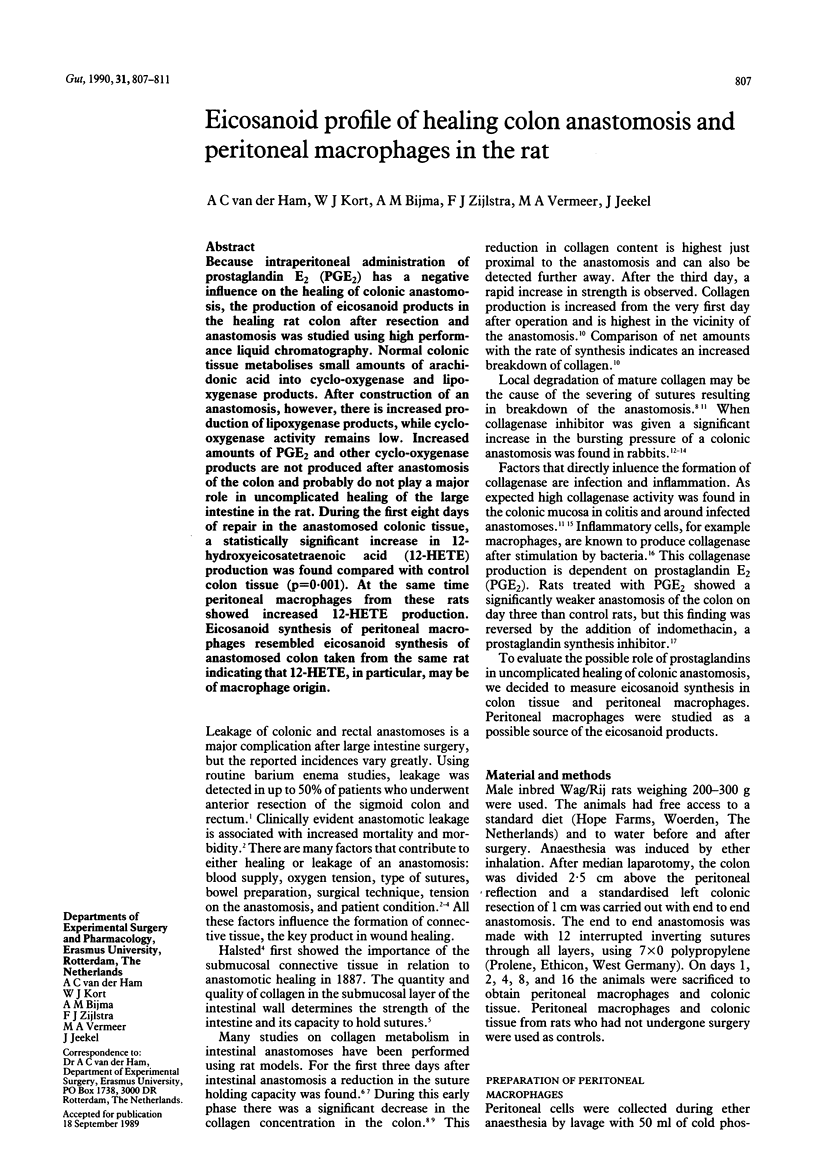
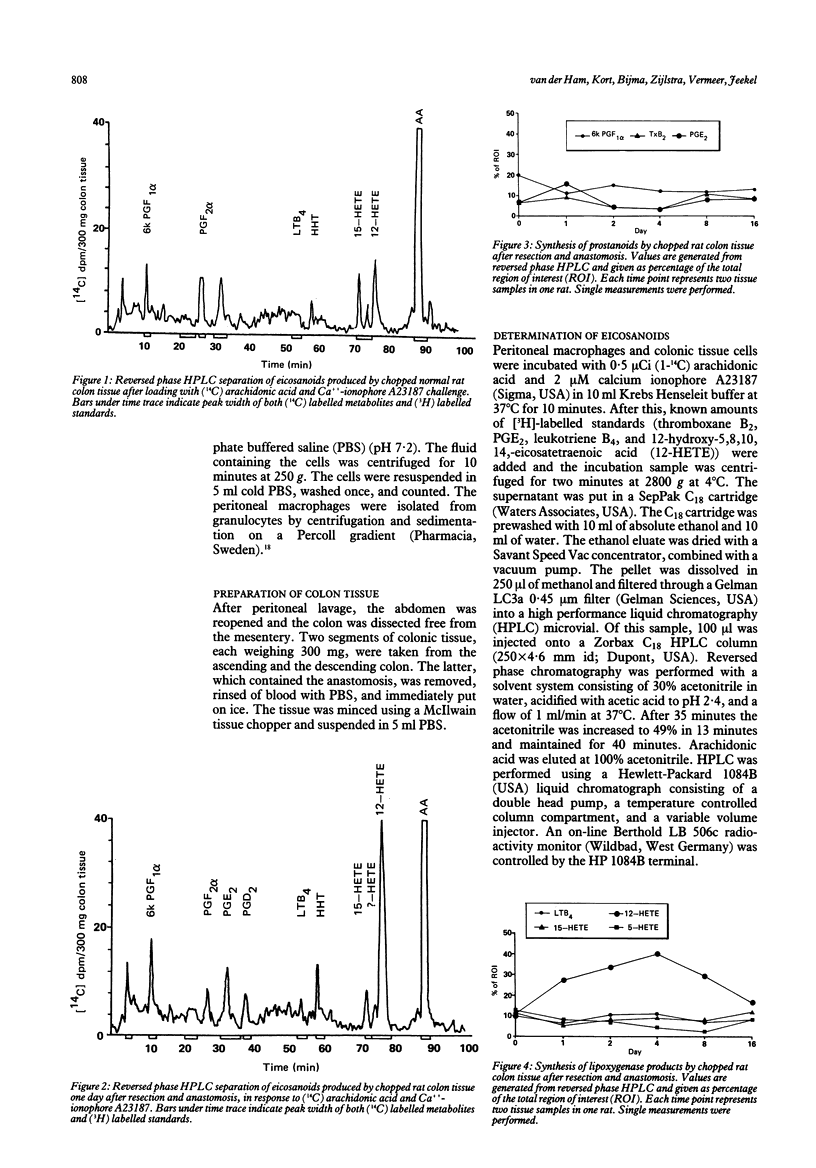
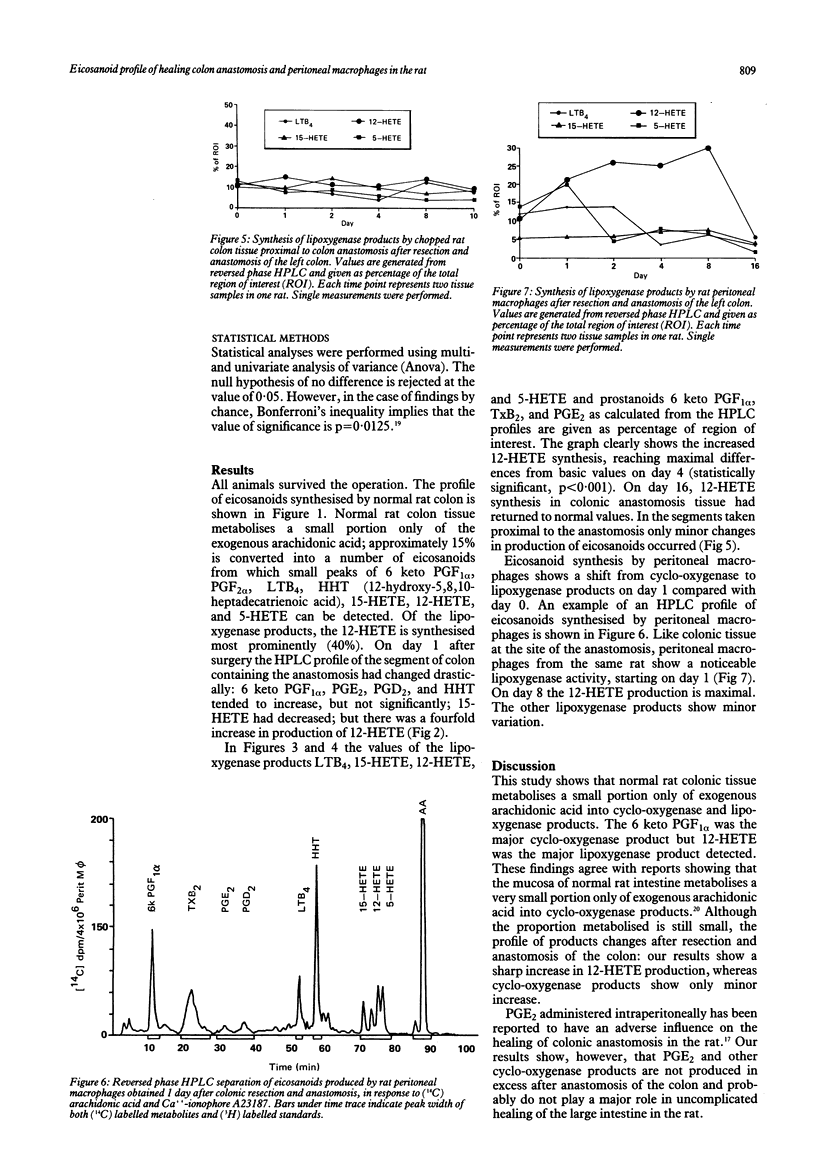
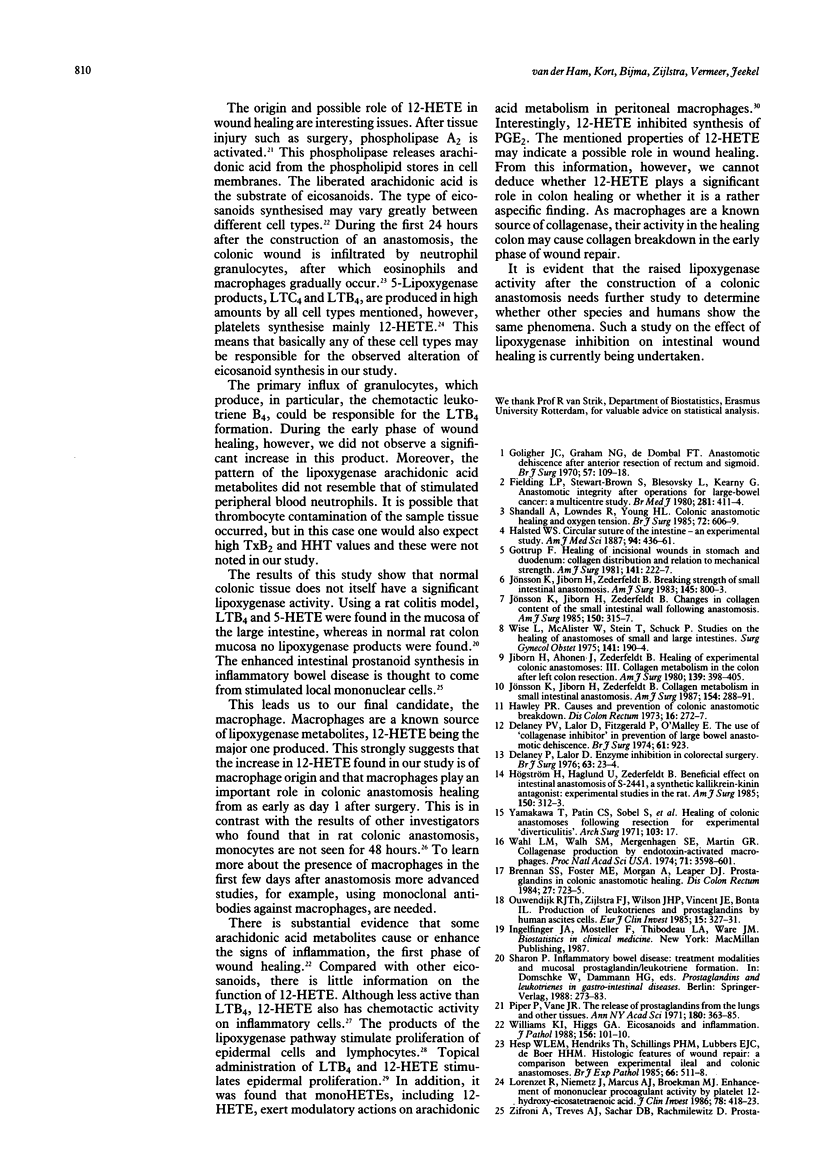
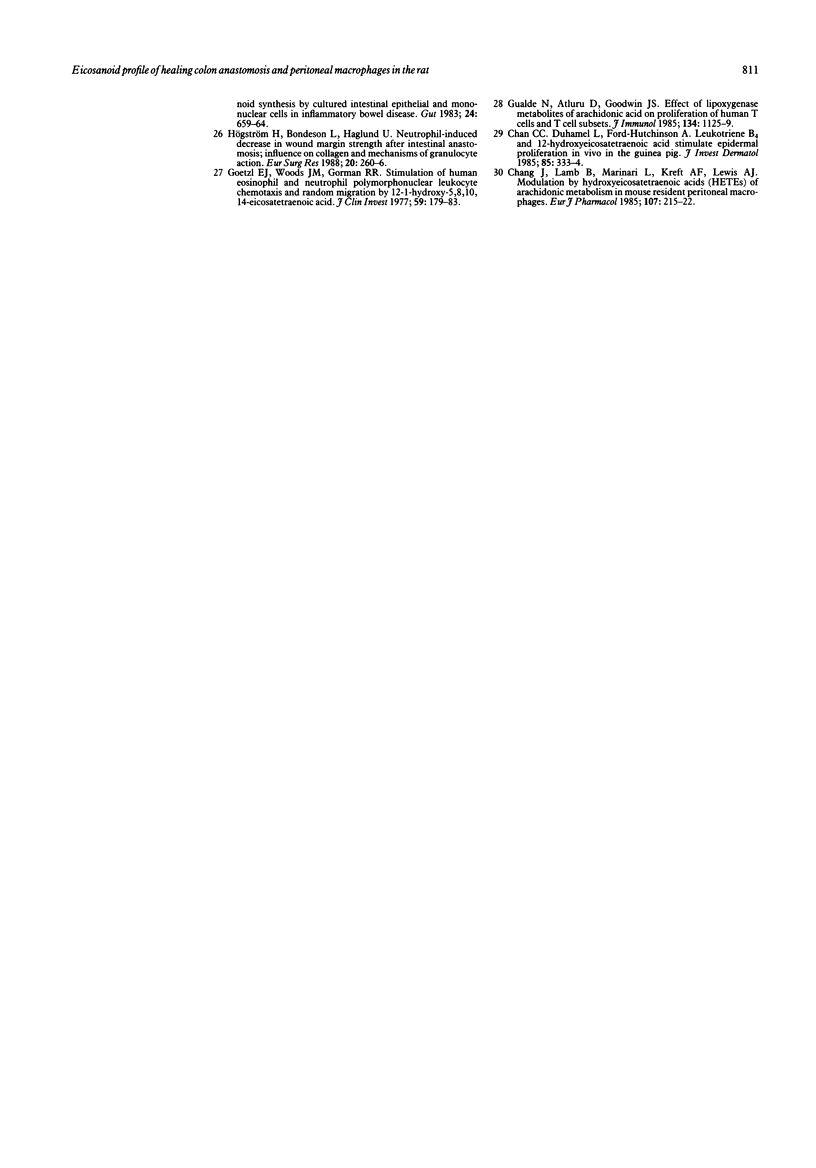
Selected References
These references are in PubMed. This may not be the complete list of references from this article.
- Brennan S. S., Foster M. E., Morgan A., Leaper D. J. Prostaglandins in colonic anastomotic healing. Dis Colon Rectum. 1984 Nov;27(11):723–725. doi: 10.1007/BF02554598. [DOI] [PubMed] [Google Scholar]
- Chan C. C., Duhamel L., Ford-Hutchison A. Leukotriene B4 and 12-hydroxyeicosatetraenoic acid stimulate epidermal proliferation in vivo in the guinea pig. J Invest Dermatol. 1985 Oct;85(4):333–334. doi: 10.1111/1523-1747.ep12276933. [DOI] [PubMed] [Google Scholar]
- Chang J., Lamb B., Marinari L., Kreft A. F., Lewis A. J. Modulation by hydroxyeicosatetraenoic acids (HETEs) of arachidonic acid metabolism in mouse resident peritoneal macrophages. Eur J Pharmacol. 1985 Jan 2;107(2):215–222. doi: 10.1016/0014-2999(85)90061-5. [DOI] [PubMed] [Google Scholar]
- Delaney P., Lalor D. Enzyme inhibition in colorectal surgery. Br J Surg. 1976 Jan;63(1):23–24. doi: 10.1002/bjs.1800630105. [DOI] [PubMed] [Google Scholar]
- Fielding L. P., Stewart-Brown S., Blesovsky L., Kearney G. Anastomotic integrity after operations for large-bowel cancer: a multicentre study. Br Med J. 1980 Aug 9;281(6237):411–414. doi: 10.1136/bmj.281.6237.411. [DOI] [PMC free article] [PubMed] [Google Scholar]
- Goetzl E. J., Woods J. M., Gorman R. R. Stimulation of human eosinophil and neutrophil polymorphonuclear leukocyte chemotaxis and random migration by 12-L-hydroxy-5,8,10,14-eicosatetraenoic acid. J Clin Invest. 1977 Jan;59(1):179–183. doi: 10.1172/JCI108617. [DOI] [PMC free article] [PubMed] [Google Scholar]
- Goligher J. C., Graham N. G., De Dombal F. T. Anastomotic dehiscence after anterior resection of rectum and sigmoid. Br J Surg. 1970 Feb;57(2):109–118. doi: 10.1002/bjs.1800570208. [DOI] [PubMed] [Google Scholar]
- Gottrup F. Healing of incisional wounds in stomach and duodenum. Collagen distribution and relation to mechanical strength. Am J Surg. 1981 Feb;141(2):222–227. doi: 10.1016/0002-9610(81)90162-8. [DOI] [PubMed] [Google Scholar]
- Gualde N., Atluru D., Goodwin J. S. Effect of lipoxygenase metabolites of arachidonic acid on proliferation of human T cells and T cell subsets. J Immunol. 1985 Feb;134(2):1125–1129. [PubMed] [Google Scholar]
- Hawley P. R. Causes and prevention of colonic anastomotic breakdown. Dis Colon Rectum. 1973 Jul-Aug;16(4):272–277. doi: 10.1007/BF02587700. [DOI] [PubMed] [Google Scholar]
- Hesp W. L., Hendriks T., Schillings P. H., Lubbers E. J., de Boer H. H. Histological features of wound repair: a comparison between experimental ileal and colonic anastomoses. Br J Exp Pathol. 1985 Oct;66(5):511–518. [PMC free article] [PubMed] [Google Scholar]
- Högström H., Bondeson L., Haglund U. Neutrophil-induced decrease in wound margin strength after intestinal anastomosis--influence on collagen and mechanisms of granulocyte action. Eur Surg Res. 1988;20(4):260–266. doi: 10.1159/000128771. [DOI] [PubMed] [Google Scholar]
- Högström H., Haglund U., Zederfeldt B. Beneficial effect on intestinal anastomoses of S-2441, a synthetic kallikrein-kinin antagonist. Experimental studies in the rat. Am J Surg. 1985 Sep;150(3):312–314. doi: 10.1016/0002-9610(85)90067-4. [DOI] [PubMed] [Google Scholar]
- Jiborn H., Ahonen J., Zederfeldt B. Healing of experimental colonic anastomoses. III. Collagen metabolism in the colon after left colon resection. Am J Surg. 1980 Mar;139(3):398–405. doi: 10.1016/0002-9610(80)90302-5. [DOI] [PubMed] [Google Scholar]
- Jönsson K., Jiborn H., Zederfeldt B. Breaking strength of small intestinal anastomoses. Am J Surg. 1983 Jun;145(6):800–803. doi: 10.1016/0002-9610(83)90144-7. [DOI] [PubMed] [Google Scholar]
- Jönsson K., Jiborn H., Zederfeldt B. Changes in collagen content of the small intestinal wall after anastomosis. Am J Surg. 1985 Sep;150(3):315–317. doi: 10.1016/0002-9610(85)90068-6. [DOI] [PubMed] [Google Scholar]
- Jönsson K., Jiborn H., Zederfeldt B. Collagen metabolism in small intestinal anastomosis. Am J Surg. 1987 Sep;154(3):288–291. doi: 10.1016/0002-9610(89)90612-0. [DOI] [PubMed] [Google Scholar]
- Lorenzet R., Niemetz J., Marcus A. J., Broekman M. J. Enhancement of mononuclear procoagulant activity by platelet 12-hydroxyeicosatetraenoic acid. J Clin Invest. 1986 Aug;78(2):418–423. doi: 10.1172/JCI112592. [DOI] [PMC free article] [PubMed] [Google Scholar]
- Ouwendijk R. J., Zijlstra F. J., Wilson J. H., Vincent J. E., Bonta I. L. Production of leukotrienes and prostaglandins by human ascites cells. Eur J Clin Invest. 1985 Dec;15(6):327–331. doi: 10.1111/j.1365-2362.1985.tb00280.x. [DOI] [PubMed] [Google Scholar]
- Shandall A., Lowndes R., Young H. L. Colonic anastomotic healing and oxygen tension. Br J Surg. 1985 Aug;72(8):606–609. doi: 10.1002/bjs.1800720808. [DOI] [PubMed] [Google Scholar]
- Wahl L. M., Wahl S. M., Mergenhagen S. E., Martin G. R. Collagenase production by endotoxin-activated macrophages. Proc Natl Acad Sci U S A. 1974 Sep;71(9):3598–3601. doi: 10.1073/pnas.71.9.3598. [DOI] [PMC free article] [PubMed] [Google Scholar]
- Williams K. I., Higgs G. A. Eicosanoids and inflammation. J Pathol. 1988 Oct;156(2):101–110. doi: 10.1002/path.1711560204. [DOI] [PubMed] [Google Scholar]
- Wise L., McAlister W., Stein T., Schuck P. Studies on the healing of anastomoses of small and large intestines. Surg Gynecol Obstet. 1975 Aug;141(2):190–194. [PubMed] [Google Scholar]
- Yamakawa T., Patin C. S., Sobel S., Morgenstern L. Healing of colonic anastomoses following resection for experimental "diverticulitis". Arch Surg. 1971 Jul;103(1):17–20. doi: 10.1001/archsurg.1971.01350070043009. [DOI] [PubMed] [Google Scholar]
- Zifroni A., Treves A. J., Sachar D. B., Rachmilewitz D. Prostanoid synthesis by cultured intestinal epithelial and mononuclear cells in inflammatory bowel disease. Gut. 1983 Jul;24(7):659–664. doi: 10.1136/gut.24.7.659. [DOI] [PMC free article] [PubMed] [Google Scholar]


